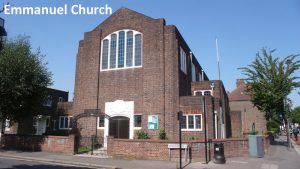
A Story of Divine Guidance.
If there be any who doubt the reality of God’s guidance of human affairs such people should study the history of the Emmanuel Mission.
The first idea of a church here originated in 1907, when, at a Vestry Meeting under the Rev. E. Davies, the hope was expressed that “a church would be established in the near future.” That was on April 5th of that year. Earnest efforts were made to realize the hope, but, two years later, April 19th, 1909, at another Vestry Meeting, there seemed no prospect of anything being done. Four years after that, April 15th, 1913, the late Sir Courtenay Warner expressed his anxious interest in the prospect, but thought it “rather early to start a scheme for building, though he thought a .way would be clear soon.”
The War, with all its distress and horror, came in the following year. It was not until May 21st, 1919, that the Rev. I. Renshaw, at a Vestry Meeting, ” hoped soon to be in a position to say what could be done, and when,” and in 1921, under the Rev. A. S. Trudgett, strong efforts were made to acquire a building site. After a series of anxious negotiations it was announced at a Church Council Meeting on September 29th, 1924, that advice had been received from the Archdeacon that the “Architect was preparing plans and that the work was definitely to commence in March, 1925.”
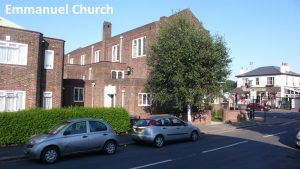
However, the prospects were still clouded. It is a matter for deep gratitude in the hearts of those who now see the realization of the hope of those days, that, even when most .dim, that hope was never given up, and it was realized that in good time prayer and effort would be rewarded.
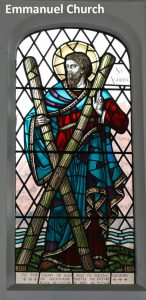 In April, 1933, the Rev. B. C. Garcia arranged for a twenty-four hour vigil of prayer in the Mission Church, and during that vigil had a very strong feeling, as of a call ‘from God, that the time was now ripe. He wrote to the Lord Bishop of the Diocese, Dr. Wilson, and the reply received proved indeed that it had been a call from God to action. ” It is very strange,” wrote the Bishop, ” that you should write to me in this strain, for I have been thinking a very great deal about Emmanuel recently. If,” added Dr. Wilson in conclusion,” what I have said encourages you to go forward, I shall be very pleased. You may be sure that you will receive all possible encouragement from me.”
In April, 1933, the Rev. B. C. Garcia arranged for a twenty-four hour vigil of prayer in the Mission Church, and during that vigil had a very strong feeling, as of a call ‘from God, that the time was now ripe. He wrote to the Lord Bishop of the Diocese, Dr. Wilson, and the reply received proved indeed that it had been a call from God to action. ” It is very strange,” wrote the Bishop, ” that you should write to me in this strain, for I have been thinking a very great deal about Emmanuel recently. If,” added Dr. Wilson in conclusion,” what I have said encourages you to go forward, I shall be very pleased. You may be sure that you will receive all possible encouragement from me.”
In June, 1934, came the Foundation Stone laying by the late Sir Courtenay Warner, and who lived long enough to see the culmination of the long and so often (to all of weak faith) seemingly unrewarded efforts. A letter from the Bishop of Barking, Dr. Inskip, contained “his congratulations and good wishes to you all with regard to the great project which you are undertaking.”
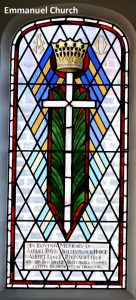 “My mind,” the letter continued, ” goes back to the old days during the years when I was Vicar of Leyton, when there were very few houses between the hill in Lea Bridge Road, and the Lea Bridge Station.”
“My mind,” the letter continued, ” goes back to the old days during the years when I was Vicar of Leyton, when there were very few houses between the hill in Lea Bridge Road, and the Lea Bridge Station.”
One very pleasing feature during the building was the placing of single bricks by individual subscribers.
The handsome “St. George” stained glass window in the North Aisle has been presented by the Architect, Mr. Martin T’ravers. Much of the Church furniture has been promised already. There now remains a debt of £1,900 on the Church, but we, hope and believe that it will not be long before this is a thing of the past.
 The Rev. H. J. Sweeney, writing the Emmanuel people on May 22nd, 1934, said “Thirty years ago my old chief, the Rev. Edwin Davies, together with the Rev. E. G. A. Dunn, and myself, were working together 200 miles away from here. In a. few months the first two came to AH Saints’, Leyton, and the Emmanuel district soon came into being. In the last four years I have seen three men labouring at Emmanuel. In the providence of God the third, your present pastor, is bringing to fulfilment all your hopes. Other men laboured, and ye are entered into their labours. May God bless and prosper you all in this great task.”
The Rev. H. J. Sweeney, writing the Emmanuel people on May 22nd, 1934, said “Thirty years ago my old chief, the Rev. Edwin Davies, together with the Rev. E. G. A. Dunn, and myself, were working together 200 miles away from here. In a. few months the first two came to AH Saints’, Leyton, and the Emmanuel district soon came into being. In the last four years I have seen three men labouring at Emmanuel. In the providence of God the third, your present pastor, is bringing to fulfilment all your hopes. Other men laboured, and ye are entered into their labours. May God bless and prosper you all in this great task.”
 The providence of God. That indeed is the true experience of the history of Emmanuel. Days of hopeful effort at hard tasks are indeed happy; faith and hope make them so.
The providence of God. That indeed is the true experience of the history of Emmanuel. Days of hopeful effort at hard tasks are indeed happy; faith and hope make them so.
We may mention, in conclusion, the interesting fact that our old friend and caretaker at Emmanuel, Mr. Knight, who has lived in the district from the very beginning of the project, has constantly offered up prayer for the building of the Church. And further, that Mr. Hastings, the Foreman, under the Architect, who has been in charge of the building, is not only Churchwarden of the Church of St. James’, Watford, but also supervised the building of that church.
“Truly all the building fitly framed together growth unto a holy temple in the Lord.”
INDICATOR.
TE DEUM LAUDAMUS.
Short Description of the Church of Emmanuel
By THE ARCHITECT
Reprinted from the Order of Service
‘Of the Service of Consecration, April 20th 1935’
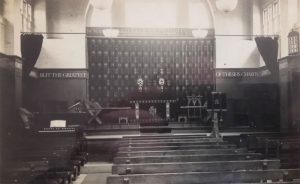
The site of the Church is, roughly, a rectangle, with Lea Bridge Road on the South Side, and Hitcham Road on the West.
On the North Side is the new Vicarage and its garden, between the Church and the Parish Hall.
The interior of the Church measures 89 ft, from East to West, and 52 ft. 4 inches, from North to South, at its widest part.
The normal seating capacity, exclusive of Clergy and Choir Stalls, is 336, but 50 seats could be added for special occasions.
The Building consists of a Nave and Chancel without a Chancel arch, so that the main roof is continuous from East to West.
A wide North Aisle terminating eastwards in a side chapel.
A narrow South Aisle, in which there are no windows, the reason for this being the necessity of eliminating, as far as possible, the noise of passing traffic.
The Choir and Clergy vestries are on the south side of the Chancel, east of the south aisle.
The Sanctuary and Side Chapel are connected by a low doorway in order that at the great festivals, when there are many communicants, the Communion Rails of both may be used for one service.
The main entrance to the Church is at the West end, and opens into a large porch under the West Gallery. There are also entrances at the West end of both aisles, and one at the east end of the south aisle, which also serves as an entrance to the vestries.
The Organ is in the west gallery, where there are also seats for 30 people.
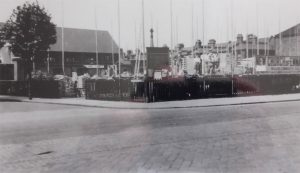
The Church is built of multi-coloured Sussex stock bricks, with red brick dressings for copings, and round the window openings, reconstructed stone is used for the external doorways and window frames and mullions.
The Nave roof is constructed of wood, covered externally with copper.
The Aisle roofs of concrete slabs covered with Asphalte.
It has, unfortunately, been found necessary to omit the cupola shown in the original design, owing to the lack of funds, but this, together with a larger bell, could be added at a later date.
the Bell, at the west end of the north aisle, is a gift, and once hung over the old schoolroom of the Church of All Hallows, Southwark.
The Nave and Aisles are furnished with chairs.